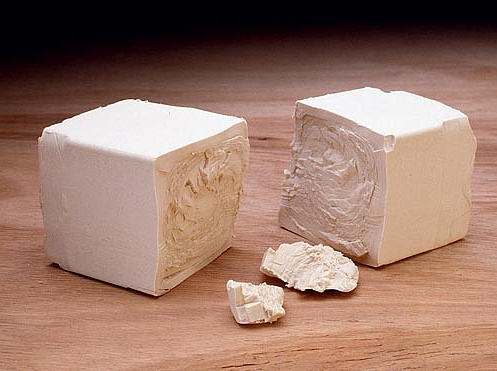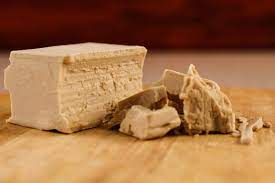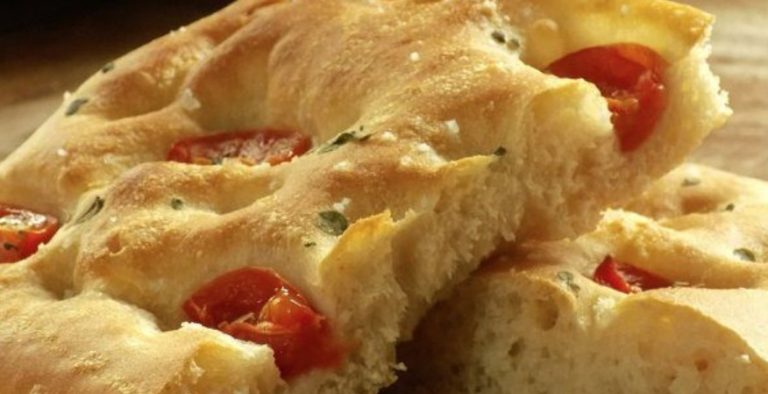Have you ever heard of Lievito Madre? Here you can find out what makes this sourdough variant special, how you can make it yourself and what delicious things you can bake with it.
Lievito Madre means mother yeast in German. It is the Italian variant of the sourdough known in Germany. You can make it yourself relatively easily and use it to bake various foods such as bread, rolls or pizza. Similar to yeast or baking powder, Lievito Madre ensures that the pastries are nice and fluffy. It has a much milder taste than German sourdough, so you can even use Lievito Madre for sweet pastries.
The next section shows you an example recipe to grow your own Lievito Madre. Don’t be discouraged if you don’t get it right on the first try. It takes time and experience to learn how the dough reacts and how best to handle it.
The sample recipe is designed so that you don’t have to throw anything away. Many recipes use relatively large amounts of ingredients and require regular disposal of appropriately sized leftovers, but this is food waste that you can easily avoid. You don’t need 100 grams or more flour for the first batch, you can also do it with less. However, dough residues always occur in the process. It is best to collect these in a separate container in the fridge and use them later when baking.

There are many different ways to schedule a Lievito Madre. Using dried Lievito Madre as a base, you can make a baking batch in just one day. Without it, the whole process takes up to 25 days at room temperature. But you can easily speed this up by placing the dough in a place that is around 28 to 30 degrees Celsius. In winter, for example, this can be with the heating, or you take a cooler and put the dough in it with a bottle of hot water, which you change regularly. In just five days at best, follow the steps below to create your own Lievito Madre.
How to make the Lievito Madre approach
Ingredients:
225 organic wheat flour
115ml water
0.5 tsp organic olive oil
0.5 tsp organic honey
Directions:
Day 1 Of the ingredients you need today: 30 g flour
15 ml lukewarm water
0.5 tsp honey
0.5 tsp olive oil Put the flour in a bowl and add the remaining ingredients. First mix the ingredients roughly with a spoon and then knead them thoroughly by hand until a smooth dough is formed. It is really important here that everything is mixed and there are no lumps. Form the dough into a ball and cut a cross in the top with a knife. Then place it in an easy-to-clean jar with a lid. Just put the lid on loosely. Place the dough in a warm place and let it rest for 24 hours.
Day 2Today you need: yesterday’s dough
25 ml lukewarm water
45 g flour Mix your dough with the water until it dissolves. Then add the flour and knead again very carefully. Place the dough in a loosely sealed jar and keep warm until tomorrow. Today, and every day that follows, it’s important to make sure the dough doesn’t spoil. If mold does form, you’ll have to get rid of it entirely and unfortunately start over. Good dough smells pleasantly of flour, yeast and slightly sour. Even a slightly alcoholic smell is not bad.
Day 3 to 5 On each of these days you will need: 50g of dough from the previous day (collect the rest in a separate container in the fridge)
25 ml lukewarm water
50 g flour Mix your dough with the water until it dissolves. Then add the flour and knead again very carefully. Place the dough in a loosely sealed jar and keep it warm on the third and fourth day until the next day. On the fifth day, the batch is placed in the refrigerator with the lid closed for further storage. The Lievito Madre should now, on the fifth day, have doubled in size compared to the previous day and be nicely bubbled. If this is not the case yet, then continue the procedure of the last few days a little longer, sometimes it just takes more time.
You can simply use the dough leftovers from the past few days for a pastry. They are very mild, so they fit in bread or roll dough as well as in sweet yeast dough.
How to properly care for your Lievito Madre
You did it and bred your first own Lievito Madre. So that you can enjoy it for a long time, it is important never to use it up completely when baking and to feed it regularly. The more dough you have, the less often you need to feed him, generally every eight to ten days is recommended. You can also use the intensity of the smell of alcohol as a guide: the more intense it is, the more urgently the dough needs more flour and water.
14 days without feeding are normally not a problem for the Lievito Madre. If you’re going to be away for a longer period of time, you’d better dry it off beforehand. To do this, only add a very small amount of water when refreshing, so that the dough is very tough.
Feeding is very easy. Take the dough out of the fridge well in advance so that it comes to room temperature. Over time, a harder layer has formed on the surface. You can remove these and simply mix them in when baking. Mix the soft part thoroughly with 50 g flour and 25 ml lukewarm water.
If you are already planning to bake a specific recipe, you can adjust the amount of flour and water to get the amount of Lievito Madre you need plus a small reserve for storage. The important thing is that you always use twice as much flour as water.
Then put the batter in a fresh jar. Wait for the dough to double in size, then place it back in the fridge with the lid on.
Lievito Madre and Sourdough – What’s the Difference?
The difference between Lievito Madre and sourdough lies in the ratio of flour to water. With classic sourdough it is 1:1, i.e. just as much flour as water. For Lievito Madre, on the other hand, you use twice as much flour as water, i.e. the ratio is 2:1 flour to water.
Another difference is that you add olive oil and honey to the base for Lievito Madre, sourdough is always just flour and water. The types of flour are also different. Rye flour is usually used for sourdough, while wheat flour is used for Lievito Madre.
As a result, Lievito Madre is less acidic and contains more natural yeasts than a classic sourdough, making it more versatile. If you already have a sourdough starter in the fridge, you can easily make a Lievito Madre out of it. The necessary steps are:
Weigh the sourdough starter and add the same amount of flour and half the amount of lukewarm water. With 20 grams of sourdough, for example, 20 grams of flour and 10 milliliters of water.
Knead everything thoroughly and place the dough in a clean, loosely sealed container.
Place the dough in a warm place for 12 hours.
Repeat steps 1 through 3, adjusting the amount of flour and water, two or three more times. The dough should double in volume within 6 hours.
In the further procedure, i.e. use, storage and feeding, you don’t have to pay attention to anything other than with the directly applied Lievito Madre.
If you’re really in the mood for baking now, you’ll find a recipe to try in the next section.
How to make focaccia with Lievito Madre

Ingredients:
70 gLievito Madre (fed the day before)
350 gorganic wheat flour
280 ml lukewarm water
1 tsp salt
1.5 tbsp organic olive oil
Herbs, olives, tomatoes or other favorite ingredients
Directions:
Knead the flour thoroughly with 230 milliliters of the water to form a dough and leave covered for 30 minutes.
Add the Lievito Madre and the salt and gradually add the remaining water while kneading for at least five minutes. You can do this by hand or with a food processor fitted with a dough hook.
Grease a flat baking pan with some olive oil.
Spread the dough out in the pan and let it rise, covered, in a warm place for at least two hours. If you have more time, you can also put it in the fridge overnight. This way the result gets even better.
Press small indentations into the dough from above with your fingers.
Brush the dough with the olive oil and spread the olives, tomatoes, or whatever you have chosen on the dough.
Bake the focaccia in the oven at 180 degrees Celsius for 20 to 30 minutes. It should be lightly browned. Actual baking time will vary by oven.







